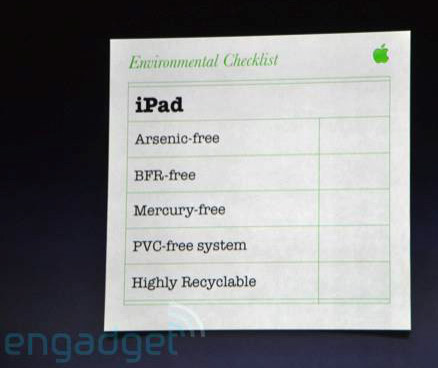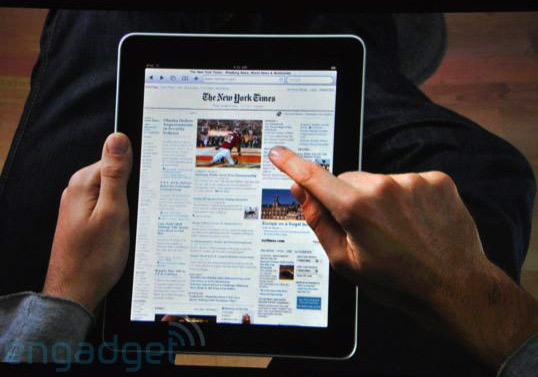 The iPad.Photo: Apple
The iPad.Photo: Apple
This post is reprinted courtesy of GreenerComputing.com.
The day that gadget-lovers have been waiting for with bated breath for months if not years has finally arrived.
On Wednesday, just after 10 a.m., Steve Jobs unveiled the iPad — something along the lines of a blown-up version of the iPhone. Weighing 1.5 pounds, just half an inch thick, and 11 inches tall, the iPad aims to be the Next Huge Thing for technology, making it possible to play music, watch movies, read books, and run all the other tens of thousands of apps available in the Apple’s application store.
At the event, Steve Jobs and various Apple execs and partners showed off the iPad’s specs, including a new iBooks e-reader application and associated bookstore, and a new version of Apple’s iWork office suite specifically for the iPad. Prices run from $499 for a 16-gigabyte model with no 3G internet, and up to $829 for a 64-gigabyte model with 3G internet.
But what we really care about is, is it green?
At the start of the event, Jobs ran down the green cred of the gizmo: In keeping with Apple’s environmental policies, the device is free of all kinds of nasty chemicals. It is arsenic-free, mercury-free, BFR-free, PVC-free, and, according to this slide, taken by the good folks (and great livebloggers) at Engadget, “highly recyclable.”

Jobs also stated that the iPad can get 10 hours of battery life — an impressive feat if it’s true. (For comparison’s sake, my brand-new MacBook Pro supposedly gets 7 hours of battery life and in reality gets around 4, unless I turn the display to near-dark and stick to processor-light tasks.)
 The vagaries of its “highly recyclable” claim notwithstanding, those are all great green attributes, and another example of how Apple is leading the way with green computing.
The vagaries of its “highly recyclable” claim notwithstanding, those are all great green attributes, and another example of how Apple is leading the way with green computing.
Still, I fail to see how this is really a game-changer for the planet.
As I wrote on Monday:
First and foremost, the production of electronics has a huge environmental impact. Precious and rare metals to build the gadgets, global supply chains to bring those materials to manufacturers (and bring those gadgets to market), and the energy used during their lifetime are the beginning of the problem.
There is also the huge problem of end-of-life management for these gadgets. Electronics recycling is at best a nascent market — as we write about all the time on GreenerComputing, and which we find in our annual State of Green Business report. At worst, we’re throwing away far more gadgets than we should be, and neither manufacturers, retailers or governments have yet put in place a good way to collect even a fraction of what’s discarded.
But the biggest problem to my way of thinking is that the tablet will just be an addition, not a replacement.
Look at the “netbook” market for cheap laptops that are designed to surf the net well — they’re often highly energy efficient, and that’s a good thing, but the vast majority of netbook owners use them as a supplement to their full-sized and full-spec laptops or desktops (and their phones, e-readers, what have you), thereby multiplying the impacts per user.
I stand by this assessment. In a nutshell, the iPad is a nifty little gadget, I’m sure it will do wonders for how people engage with technology, and hopefully will give a boost to the flagging newspaper and book-publishing industries, but it is still another resource-intensive gadget that will be an add-on rather than a replacement.
More pics below.




